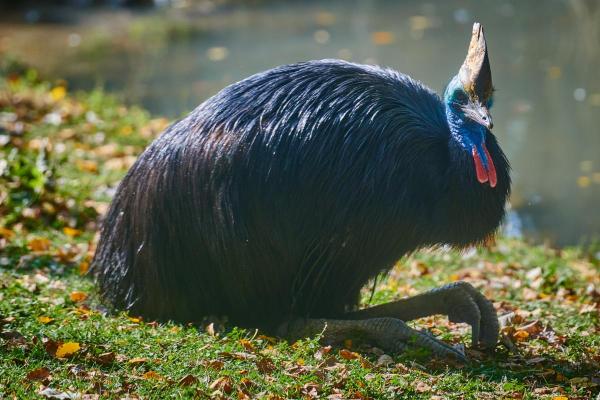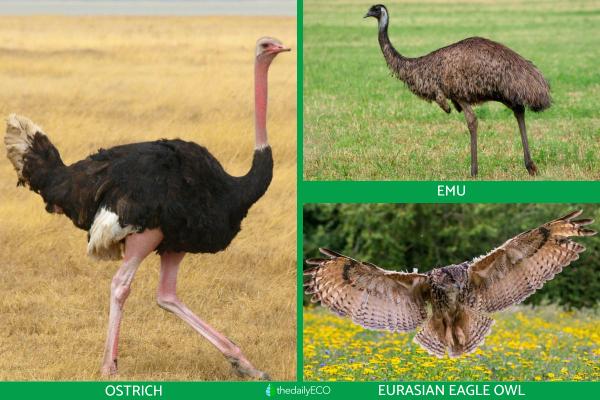
The southern cassowary (Casuarius casuarius) is considered the most dangerous bird in the world due to both its physical characteristics and its temperament. It is a large bird with long sharp claws at the end of very powerful legs. Other birds may also have similar characteristics, but the cassowary is considered particularly aggressive when they feel threatened. These Oceanic birds prefer to avoid contact with humans. This means that incidents between the two are fortunately rare. thedailyECO explores the threat these birds provide in our article asking what is the most dangerous bird in the world?
What is the cassowary?
Birds of the genus Casuarius are known as cassowaries, of which the largest is the southern cassowary (Casuarius casuarius). While it may depend on the parameters, it is considered by many to be the most dangerous bird in the world.
Their reputation for being so dangerous is partly due to their large size. While not the biggest bird in the world, they can reach heights of up to 6.5 ft (2 m) and weigh up to 154 lb (70 kg). This means they have a lot of physical strength, concentrated in very muscular legs which can kick with incredible power. At the end of these legs are incredibly sharp claws which can slash flesh with ease. They are considered similar to velociraptor claws.
Other large birds have similar physical features, but the cassowary's status as the most dangerous bird in the world is largely thanks to a mean temperament. While they will not go out of their way to pursue humans, they can be incredibly territorial. This means they can attack out of a need to mark their territory, as well as protect themselves from possible attack.
Although they have a strong peck and a hard casque on their head, southern cassowaries attack by kicking with their legs. Along with their sharp claws, they can kick very violently. Despite its reputation, incidents involving humans are extremely rare. Most have occurred in situations where the cassowary has been bred in captivity or has been forced to defend itself because it feels threatened.

Characteristics of the most dangerous bird in the world
We have already explained some of the physical and behavioral characteristics of cassowaries. These combine to make them dangerous, but we provide more detail of these cassowary characteristics below:
- These flightless birds are very heavy, the second heaviest bird after the ostrich. In addition to size, you can learn more about how birds are classified with our related article.
- They present sexual dimorphism since females are larger than males and have more vivid colors.
- They are crepuscular and nocturnal, meaning they are most active during dawn and dusk. They usually rest during the day. Learn more about other nocturnal birds with our article on the difference between true owls and barn owls.
- Cassowaries are solitary and shy, tending to hide in the presence of humans.
- Although their diet consists primarily of fruits, they are considered opportunistic omnivores and may also consume fungi, invertebrates, carrion, eggs and other food items.
- The cassowary plays a fundamental role in ecosystems as a seed disperser. You can discover more about this process with our article explaining how plants disperse seeds.
- It has a horn-like structure called a casque on its head. These are calcified structures covered in keratin which measure between 5-6" (13-16 cm). It provides protection when moving through the dense vegetation of its habitat, although it can also use it as a method of defense if it feels threatened.
- Their strong limbs contain sharp claws that can cause serious injuries, likened to those of their ancestor the velociraptor.
- It emits very characteristic low-frequency sounds that it uses to communicate.
- The female can mate with several males. It lays three to four eggs at a time, depositing them on leaves on the jungle floor. The male incubates them and cares for the young along with the female.
- In Australia, their populations have historically been declining due to habitat loss and fragmentation. Many individuals are affected by cyclones and road accidents. In Indonesia and Papua New Guinea, the species is hunted, captured and traded near populated areas. It is of great cultural significance and constitutes an important food source for various communities.
- According to the IUCN Red List of Threatened Species, the cassowary's population size suggests it is larger than previously estimated. While threats are present, they are not impacting global populations as previously feared. Coupled with its widespread distribution, this means the species is no longer considered vulnerable. It has now been classified (according to its latest assessment in August 2018) as of ‘Least Concern’.
- More than a dangerous bird, the cassowary is a symbol of the biodiversity of Australia and New Guinea. Its imposing appearance and behavior make it one of the most fascinating birds in the world. Focusing efforts on the conservation of its populations and habitat are key to ensuring its long-term survival and that of other species.
The cassowary beak is sharp, pointed and very hard. This can also provide some danger if you were to be attacked by a cassowary. It is especially adapted to eating fruit, using their long neck to reach it. Learn more about the different types of bird beaks there are in nature.
Other dangerous birds
It's important to note that the term dangerous is a relative concept. These are the birds which are dangerous to humans if they were to attack us, but other birds kill many more people thanks to the spread of diseases such as avian flu or salmonellosis. If we consider the deadliness of birds according to their ability to attack, some other of the most dangerous birds in the world are the:
- Ostrich (Struthio camelus): is the largest and heaviest bird in the world. It is considered dangerous due to the great strength of its legs. Like the cassowary, they are equipped with powerful claws capable of causing serious injuries or even killing a potential predator if threatened.
- Emu (Dromaius novaehollandiae): is the largest bird in Australia and the second tallest in the world, surpassed only by the ostrich. Although it is generally peaceful and will flee in the face of danger, its powerful legs are also equipped with sharp claws and can pose a risk if it feels cornered or threatened.
- Eurasian eagle Owl (Bubo bubo): is one of the world's largest nocturnal birds of prey, with extremely strong talons. Although not a danger to humans under normal conditions, it can become aggressive if threatened or if someone invades its territory. This is especially so during the breeding season. There have been reports of it attacking humans who approach its nests too closely, using its sharp talons to defend itself. Despite this, it prefers to keep its distance from humans and hunt in the darkness.
You can learn more about the connection between current birds and their prehistoric ancestors with our article asking were there flying dinosaurs?

If you want to read similar articles to What Is the Most Dangerous Bird in the World?, we recommend you visit our Facts about animals category.
- EBird. Available at: https://ebird.org/explore
- IUCN (2024). The IUCN Red List of Threatened Species. Available at: https://www.iucnredlist.org